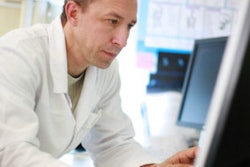
Analyzing paintings that depict radiology encounters with patients can positively shift attitudes medical students have about radiology, according to a study published online May 9 in Academic Radiology.
Using art to give medical students a better understanding of radiology's key role in patient care can only benefit the specialty, wrote a team led by Dr. Kari Visscher of The Ottawa Hospital in Canada.
"Radiology can be the crossroads of medicine, the place where medical specialties collaborate; where everyone is welcomed and respected; where engaging and enlightening conversations are had; and most importantly, where optimal patient care and management is determined," the group wrote. "Unfortunately, this is often not the perception of medical students who continue to believe the stereotype of the isolated radiologist working in a dark room."
The stereotype is spread through casual exchanges among students, Visscher's group wrote. And it can negatively affect the specialty if it's not addressed since the exposure students have to radiology in preclinical years can have a lasting effect on their perception of the field and may impact their career choices, the authors noted.
"According to a qualitative study looking at the perceptions that medical students have of radiology and radiologists, this stereotype is perpetuated mainly through informal interactions, the so-called 'hidden curriculum' and the lack of contradictory information early in medical school," the researchers noted. "Fortunately, students ... want accurate information to either challenge or reinforce these beliefs.
Visscher's group conducted a study that included 50 third-year medical students rotating through a one-week radiology elective. All of the participants analyzed three paintings, which Visscher painted herself, using the Visual Thinking Strategies teaching method and completed a post-analysis questionnaire.
 Radiologist dictating (above) and interventional radiologists taking out a portacath in a patient (below). Images courtesy of Dr. Kari Visscher; copyright Kari Visscher.
Radiologist dictating (above) and interventional radiologists taking out a portacath in a patient (below). Images courtesy of Dr. Kari Visscher; copyright Kari Visscher.Of the study participants, 82% found the exercise "very enjoyable," 86% stated that the paintings positively influenced their understanding of how radiologists provide patient care, and 96% said the teaching method was useful, according to the researchers.
"Exploring representational paintings of radiology encounters seemed to influence perception and understanding of radiology, with students reporting 'light bulb moments,' " Visscher and colleagues wrote.
These insights helped broaden students' understanding of the radiologist's role -- allowing them the opportunity to see the human interaction involved in radiology, as one study participant specifically noted.
Art can really help change student perceptions of the specialty, according to Visscher's group.
"The findings of this study suggest that analyzing paintings depicting radiology encounters with patients can challenge negative stereotypes that medical students have of the radiology profession and radiologists," the authors concluded. "This arts-based learning module ... should be considered by the radiology profession as a strategy to positively inform and educate trainees."



















